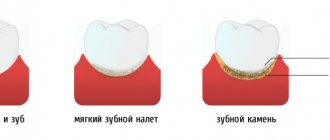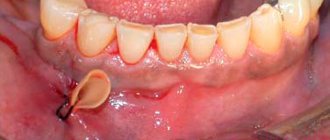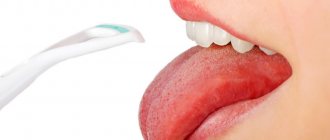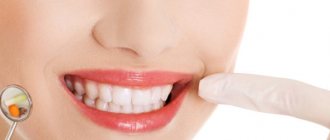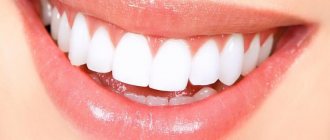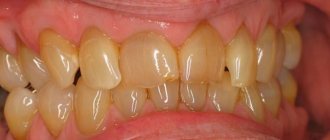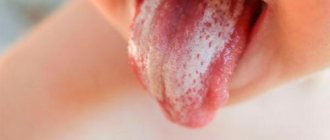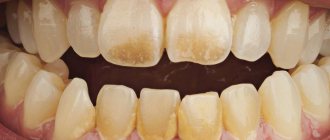The presence of black (dark) plaque on the teeth is not only aesthetically unpleasant, as it spoils the appearance, but also signals that dental treatment is necessary (possibly urgently). Dental Med specialists in Odintsovo will help you find out and eliminate the root causes of the problem, and also get rid of unsightly plaque using safe and modern methods.
Consumption of certain foods and drinks
Black plaque as in the photo often appears in those people who love strong tea and coffee without milk, red wine, Coca-Cola, dark chocolate, currants, blueberries, and pomegranates. The fact is that these products contain a large amount of dyes and polyphenols, which color the enamel in an unpleasant dark shade. Polyphenols are powerful antioxidants, but frequent consumption of foods rich in these substances and lack of basic oral hygiene after eating and drinking play a cruel joke on some people.
The photo shows stains from tea and coffee
If you do not want your teeth to become covered with black plaque, then after eating food and drinks, do not forget to thoroughly rinse your mouth with water or mouthwash. In the evening and morning, be sure to clean with paste, brush, floss and irrigator. If the pigment does appear, then a complex of professional hygiene at the dentist will help to cope with it.
We must also not forget that some of these foods and drinks (coffee, sweet carbonated drinks, berries) have high acidity, due to which the enamel becomes more porous and rough, which means that any pigment penetrates into it more easily.
Excess iron in the body
In the oral cavity of any person there is a large number of bacteria, including actinomycetes. In the process of their life activity, they produce hydrogen sulfide, which, when interacting with iron (contained in saliva, red blood cells, gingival fluid), contributes to the staining of teeth in black and brown shades.
Which leads to the problem:
- taking antibiotics and vitamins with iron: of course, if you have just started taking such medications, do so according to your doctor’s instructions and strictly follow the instructions (iron is taken in courses), then the problem is unlikely to arise. If you start taking medicine without a prescription or take it for a long time, then your teeth may turn black,
- using tap water with a high iron content for preparing food and drinks,
- work in hazardous industries associated with the processing of iron, as well as copper, manganese, nickel: when inhaled, particles of harmful metals settle on internal organs and teeth.
Excess iron can also stain teeth black
“My child was 3 years old when the doctor suggested strengthening his teeth with silver. This proposal arose due to the fact that we had caries. Without hesitation, I agreed, and then I really regretted it, because after silvering, the enamel became very black after some time and now we don’t know how to get rid of it. But the doctor didn’t even warn about such consequences!”
Baby_mama, review from babyblog.ru
Bacterial plaque.
Bacterial plaque on teeth is also called soft microbial plaque. It consists of colonies of microorganisms (bacteria), and has a soft, loose consistency, due to which it is easily removed from the teeth with a regular toothbrush. It accumulates mainly in the neck area of the teeth.
If bacterial plaque has a hard consistency and is not removed from the teeth during brushing and paste, then it is more correct to call it tartar. The latter occurs when soft microbial plaque is mineralized by calcium and phosphorus salts contained in saliva. Mineralization causes the plaque to harden and can no longer be removed with a regular toothbrush.
Bacterial plaque: causes of formation.
The oral cavity contains a lot of bacteria, and they constantly multiply. Even on well-cleaned teeth, after just 6 hours, a mass of bacterial plaque is clearly visible to the eye. But the maximum increase in the number of bacteria occurs immediately after eating, which is due to the presence of food residues that bacteria begin to process.
And for this, bacteria do not need large pieces of food between the teeth - they only need the invisible film of carbohydrates and proteins that remains on the teeth after eating, not to mention the fragments of food remaining in the interdental spaces. That is why it is so important to brush your teeth in the first 10 minutes after eating, including mandatory cleaning of the interdental spaces with dental floss.
Otherwise, the mass of bacterial plaque will increase tenfold within a few hours. And you can easily notice white plaque on the teeth, accumulating mainly in the neck area. Plaque forms especially quickly in people who, in between main meals, like to snack on candy or a bun, or sweet drinks, without brushing their teeth afterwards.
Important: as we have already said, after the formation of bacterial plaque, the process of its gradual mineralization immediately begins, as a result of which the soft plaque begins to turn into hard tartar. The time of primary mineralization, when the soft plaque seems to “set”, occurs within approximately 10–16 hours. As a result, the plaque hardens (although after this time it still remains a little loose) and it is almost impossible to remove it with a regular manual toothbrush.
When plaque has already firmly adhered to the surface of the teeth, this facilitates the adhesion of new portions of plaque to the teeth, which leads to the rapid formation of layers of dental plaque. Thus, there is only one cause of dental plaque – insufficient oral hygiene. But there are also predisposing factors, for example: mouth breathing, low levels of lysozyme in saliva.
Abuse of chlorhexidine-based mouthwashes
Teeth inevitably become covered with black plaque if you rinse your mouth with Chlorhexidine or rinses that contain this medicinal substance for a long time. Chlorhexidine fights bacteria and viruses well, helps eliminate the inflammatory process in the mucous membrane, helps damaged tissues recover faster, reduces bleeding gums, but it cannot be used for longer than 10–14 days in a row.
The enamel can also darken due to the abuse of rinses that contain benzalkonium chloride, as well as essential oils. Products with such components are not suitable for daily use. They are used only in courses and according to indications, for example, in complex therapy for the treatment of gingivitis or periodontitis.
Multiple caries
Caries is not plaque, but a dental disease. However, it is precisely when the teeth become black. It should be noted that in the early stages of development, white or yellowish spots appear on the enamel, but they become black only as the tooth decays and the disease progresses.
Black color can also indicate the presence of tooth decay
A tooth can turn black due to injury and death of the pulp, or if it is depulped. In this case, the problem of smile aesthetics, depending on the clinical picture, can be solved by intracanal whitening, installation of veneers or crowns.
“Bottle” caries is common in children, in which the teeth, especially the front ones, become very black. If you do not want to face this problem, then do not give your baby sweet mixtures and juices at night.
“My tooth, on which there was a filling, turned black, it turned black right along the edge. I didn’t pay attention to it for a long time, because it was chewy—the blackness was not visible. I went to the doctor only when pain appeared. It turned out that the filling had moved away from the walls of the tooth and began to fit loosely, which I did not notice. Bacteria penetrated there and gradually repeated caries formed ... "
Larisa N., review from woman.ru
Priestley's Raid
The Priestly plaque on the teeth that you see in the photo occurs only in children. Adults do not have this problem. Pathology appears on milk units due to the characteristics of the microflora of the oral cavity and the presence of bacteria in it, which make the enamel black.
The photo shows Priestley's raid
It is believed that this problem does not pose a potential threat to the child’s health, but it is a serious aesthetic defect that one would like to get rid of. Fortunately, today doctors know methods that will help remove black plaque and put teeth in order. If you bring your child to the dentist, the specialist will carefully remove the pigment and polish the enamel using sandblasting machines, pastes and silicone brushes.
Remember that Priestley's nonspecific plaque may appear again a few months after cleaning at the dentist. To prevent this from happening, you need to reduce the activity of the bacteria that provoke it. Eliminating dysbiosis and maintaining good immunity in the child will help with this.
Diseases of the body
Black plaque on the upper and lower teeth can occur in those who have general systemic diseases of the body. Most often, pathology appears if a person has problems with the gastrointestinal tract: high acidity, gastritis, ulcerative lesions, dysbiosis, gastroduodenal reflux (when bile from the duodenum is thrown into the stomach or from the stomach into the esophagus), bending of the gallbladder. Teeth can turn black due to problems with the liver and kidneys, bile ducts, and dysfunction of the endocrine system.
Removing black plaque or performing whitening procedures in a dental office will be short-lived, ineffective and pointless if you are not going to treat the underlying disease of the body that caused the problem.
Problems with the gastrointestinal tract can also cause the problem
What to do?
Many people want to clean their teeth from plaque at home. To do this, they use special bleaching pastes, soda, activated carbon, 3% hydrogen peroxide solution, and lemon juice. Sometimes, with slight darkening of the enamel, these methods give the desired effect.
But if you abuse such bleaching, as well as in case of increased sensitivity of the enamel, you can only harm yourself. Therefore, if you want to return your teeth to a snow-white shade, you need to start with a visit to a specialist. The dentist will assess the condition of the enamel, identify diseases of the oral cavity (if any) and recommend the best option for cleaning teeth from plaque.
In a clinical setting, there are several ways to get rid of deposits. Let's consider them in as much detail as possible. This will allow you to go for a consultation with a “theoretical savvy” specialist.
Smoking cigarettes and cigars
Black-brown plaque, tightly adjacent to the necks of the teeth on the inside of the row, appears as a result of smoking. In the process of smoking a cigarette or cigar, resins and carcinogens are deposited on the enamel, which contribute to pigmentation. This bad habit provokes the emergence of many dangerous problems and dental diseases. Which ones? You can read more about this in the feature article on our website.
Do not forget that by consuming cigarettes, you expose the enamel to strong temperature changes, due to which it cracks, and any pigment from food and drinks gets into the cracks much more easily.
Notice
: Undefined variable: post_id in
/home/c/ch75405/public_html/wp-content/themes/UltraSmile/single-item.php
on line
45 Notice
: Undefined variable: full in
/home/c/ch75405/public_html/wp-content /themes/UltraSmile/single-item.php
on line
46
Rate this article:
( 1 ratings, average: 5.00 out of 5)
plaque
- Evteev S.S., Lebedeva S.N., Kharitonova T.L. Etiological factors of dental discoloration // Bulletin of medical Internet conferences. – 2021.
Expert “In order to prevent plaque from spoiling your smile, you need to undergo preventive examinations at the dentist and professional hygiene twice a year. It must be remembered that plaque can form not only on natural teeth, but also on artificial materials used for restorations. Restored teeth also require careful hygienic care.” Dentist-therapist Elina Ruslanovna Dzagurova
Consulting specialist
Dzagurova Elina Ruslanovna
Doctor rating: 9.5 out of 10 (2) Specialization: Dentist-therapist Experience: 10 years
Prevention of black plaque on teeth
If the plaque is a consequence of smoking a large number of cigarettes or drinking an excessive amount of coffee per day, a natural way of prevention would be, if not a complete cessation of bad habits, then at least minimizing the scale of the “disaster.”
Oral hygiene is a prerequisite for a beautiful smile. If the enamel is regularly cleaned efficiently, its surface is perfectly smooth and slippery. It is much more difficult for plaque, and later for pigmented particles, to attach to such a tooth. In addition to double brushing and flossing, it is recommended to ensure that natural fiber is present in the diet - in the process of chewing such food, the surface of the teeth self-cleanses.
If the patient does not have gum problems, an electric toothbrush can be used instead of a regular toothbrush. In parallel with cleaning the surface, such a brush provides a polishing effect.
Comments
Recently, my wisdom tooth, which had been in for sooo long, finally came through completely. But it came out black and ached a little when pressed. What could it be?
Alice (04/12/2020 at 5:14 pm) Reply to comment
- Dear Alice, perhaps the wisdom tooth was affected by caries, pulpitis or periodontitis even before it completely broke through. You need to be examined by a dentist to find out the cause of the problem and begin treatment. If treatment is not practical, the tooth will have to be removed.
Editorial staff of the portal UltraSmile.ru (04/17/2020 at 09:17) Reply to comment
I heard that some materials that dentists use to treat teeth can cause blackening of the enamel. Is this really so, what to fear during treatment?
Lyubov Vladimirovna (04.05.2020 at 12:21) Reply to comment
- Dear Lyubov Vladimirovna, in the past, dentistry actually used materials that could cause darkening of teeth, for example, silver amalgam fillings, but today they are not used, so treat your teeth without fear.
Editorial staff of the portal UltraSmile.ru (05/11/2020 at 09:20) Reply to comment
I have a very dark coating on my nylon dentures, can I bleach it?
Alexander Mikhailovich (05.28.2020 at 22:17) Reply to comment
- Dear Alexander Mikhailovich, nylon absorbs various dyes well and requires daily and very careful care. Unfortunately, artificial denture materials cannot be bleached. You, of course, can try to clean them with special tablets or take them to the dentist for professional cleaning, but such a measure will not remove deeply ingrained pigment; it will only remove superficial stains and destroy bacteria.
Editorial staff of the portal UltraSmile.ru (06.06.2020 at 14:09) Reply to comment
Write your comment Cancel reply
How to remove plaque from teeth at home.
You can remove plaque from teeth at home, firstly, using special toothpastes (they are called whitening). Such pastes can remove not only pigmented plaque from the surface of teeth, but also partially mineralized plaque, and even small tartar.
But only high-quality whitening pastes will do this well. In the composition of such pastes you can find both abrasive substances and agents that loosen dense plaque:
- Abrasive substances - the degree of abrasiveness of toothpastes can be judged by the abbreviation RDA. Pastes for removing plaque must have an RDA of 100 units or higher. The higher the abrasiveness, the higher the effectiveness in removing plaque. Naturally, such pastes cannot be used constantly. You should not buy pastes of this type where the manufacturer does not write the RDA index.
- Substances that loosen plaque - these include primarily pyrophosphates, which have the property of dissolving the tartar matrix, as well as enzymes such as bromelain and papain, as well as polydone. These substances make plaque looser, making it easier to remove with the abrasive component of toothpastes.
PRESIDENT White Plus toothpaste:
- PRESIDENT White Plus toothpaste
- abrasiveness – RDA 200 ,
- contains: abrasive and polishing substances (silicon dioxide and diatomite), as well as calcium glycerophosphate,
- applied only once a week,
- price: from 230 rub. for 30 ml,
- removes severe plaque and even small stones.
Toothpaste LACALUT White:
- abrasiveness – RDA 120,
- contains: abrasive and polishing agents (hydrated silicon dioxide, titanium dioxide), pyrophosphates , sodium fluoride (1357 ppm),
- price: from 240 rubles for 50 ml, from 300 rubles for 75 ml.
Using special toothbrushes.
Removing pigmented and mineralized plaque will be even more effective if you use the following types of brushes to brush your teeth rather than a regular manual toothbrush...
- Ultrasonic toothbrushes - brushes of this type have a built-in generator that produces oscillatory waves in the ultrasonic range (about 1.6 MHz). These waves effectively destroy the attachment of plaque to tooth enamel, and will relieve you of pigmented plaque and even small supragingival tartar.
- Electric toothbrushes - brushes of this type have a working head with bristles, which performs rotational reciprocating movements (about 8 thousand revolutions per minute), as well as about 20 thousand pulsating movements per minute. Such pulsations break up the dense attachment of pigmented or partially mineralized bacterial plaque to the surfaces of the teeth, and rotational movements then help to remove it.
